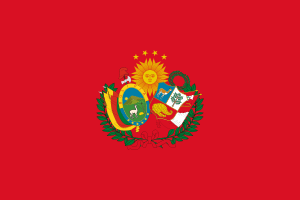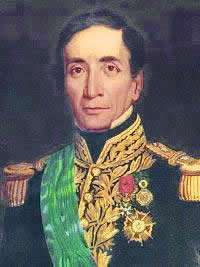Battle of Yungay
| Battle of Yungay | |||||||
|---|---|---|---|---|---|---|---|
| Part of the "War of the Confederation" | |||||||
 Planning map for the Battle of Yungay | |||||||
| |||||||
| Belligerents | |||||||
|
|
United Restoration Army
| ||||||
| Commanders and leaders | |||||||
|
|
| ||||||
| Strength | |||||||
| 6,000 | 5,400 | ||||||
| Casualties and losses | |||||||
| 3,000 casualties[1] | 664 casualties[1] | ||||||
The Battle of Yungay (or Yungai) was the final battle of the War of the Confederation, fought on January 20, 1839, near Yungay, Peru. The United Restorative Army, an alliance consisting of the Chile led by Manuel Bulnes and North Peruvian dissidents, attacked the remaining Peru-Bolivian Confederation forces led by Andrés de Santa Cruz in northern Peru, 200 kilometers (120 mi) north of Lima.
The decisive battle resulted in victory for the United Restorative Army following six hours of fighting, effectively dissolving the Peru-Bolivian Confederation and ending the War of the Confederation. Santa Cruz exiled himself in Guayaquil, Ecuador, and the new Peruvian government paid Chile's debt for the war, with decorations and awards handed out to Chilean and Peruvian officials.[2] Peruvian officers who served under the Confederation, including Guillermo Miller, Mariano Necochea, Luis José Orbegoso, Domingo Nieto, were banned from the Peruvian Army.
The victory of Yungay is remembered by the Chilean Army with the "Hymn of Yungay", and by Peru with the creation of the Ancash Region.
Prologue

Led by Rear Admiral Manuel Blanco Encalada, the first Chilean incursion into Peruvian territory, during the war between Chile and the Peru-Bolivian Confederation, was defeated at the Battle of Paucarpata by Andrés de Santa Cruz forces, Blanco Encalada and Santa Cruz signed the Treaty of Paucarpata on 17 November 1837. By signing this pact, Chile agreed to resume the commercial trade and the Confederation would recognize and pay the Chilean efforts in the Peruvian independence war.
Upon Blanco Encalada's return, however, the Chilean Congress and the public opinion rejected the treaty and organised a second expedition of 5,400 soldiers under General Manuel Bulnes, along with 600 expatriate Peruvians under General Agustín Gamarra serving as reinforcements.
Andrés de Santa Cruz, the Bolivian Marshall, responded immediately reinstating the hostilities. The second Chilean campaign had more success than the first one as the Restoring Army marched into Lima, after defeating Confederate General Orbegoso at the battle of Portada de Guías on 21 August 1838. Also, the Chilean Fleet secured sea domination in the Battle of Casma.[3]
Despite this victory, and forced by the lack of supplies and diseases, the Restorer Army marched to Huacho in the North Peruvian territory abandoning the capital city by November 1838, as news arrived indicating that Santa Cruz was closing with an outnumbering army to Lima. Afterwards, Santa Cruz entered into the city under popular ovation, then proceeded to follow Bulnes' forces.
Both armies engaged in the Battle of Buin, on 6 January 1839, in the confluence of the Buin and the Santa rivers, with indecisive results.[4] Bulnes continued marching north and Santa Cruz resumed the persecution seeking to deliver a final blow to the Chilean Expeditionary Force to cement Confederation's dominance in the region.
Thus, Santa Cruz occupied Yungay, trying to cut the Chilean supply lines and strangle the Chileans. His intention wasn't to obliterate the Restorer Army, but rather to force Bulnes to surrender to a superior Peruvian force. Bulnes had other plans however, knowing that returning empty-handed was not an option after Blanco Encalada's failure.
Contenders

Both armies had approximately 6,000 men, although the numbers favored slightly the side of the Confederation and Santa Cruz. The Chilean expedition, on the other hand, suffered the decimation of some battalions by plagues during its occupation of Lima, the capital of the North-Peruvian Republic. Comparably equipped, the main difference was in the preparation of the troops, the knowledge of the terrain, and the obvious differences between invaders and defenders.
Confederate Army
The Confederate Army was made up of veterans of internal battles from both Peru and Bolivia. It was generally supported by the population of Peru and possessed strong supply lines thanks to the site of the battle. Its commanding officer, General Andrés de Santa Cruz; was regarded as a resourceful tactician and a capable leader. His army had about 6,000 men divided into three divisions, adding up nine infantry battalions and two cavalry regiments.
Chilean Army
The Chilean Expeditionary Force had the experience of Gen. Manuel Bulnes. On the other hand, it was not popular with the locals and was hampered due to disease, bad morale, and some less experienced units. This army of 5,400 soldiers was conformed by nine infantry battalions and three cavalry regiments grouped into four divisions.
Preliminary moves
Both armies marched under the rain, and established near Tarar from where it marched towards San Miguel. Santa Cruz after detaining in Tarhuaz, occupied the town of Yungay on 13 January.
On the night of January 19, Santa Cruz sent Colonel Rodriguez Margariños to observe the Chilean positions. Besides, ordered that Bolivian Colonel Anselmo Quiroz with 600 soldiers to take positions on the Pan de Azúcar Hill, while Colonel Fructuoso de la Peña advanced to the Punyán Hill with another 200 soldiers.
On 20 January, at dawn, Gen Bulnes marched with his four divisions to Yungay, whilst Santa Cruz deployed his army by the Ancash River, with Herrera's division on the right wing, in the middle was set the artillery and behind it the cavalry led by General Perez de Urdinea. Finally, Moran's division was stationed on the left flank.
Battlefield
Both forces were separated by a short valley formed by the Santa River and the mountains, with the Punyán, Ancash and Pan de Azúcar hills at the far end of this site, behind these heights lay the deep Ancash Glen, followed by the Confederate trenches.
The battle
Confrontation on the Punyán and Pan de Azúcar hills
Bulnes decided to attack the Confederates at Punyán Hill first. The Aconcagua Battalion was dispatched to clear out the hill, which climbed and forced Peña's companies to retreat. After them, Bulnes sent the Portales, Valdivia and Huaylas battalions.
At 9 am, a column of 400 soldiers under Jerónimo Valenzuela and formed by companies of the Carampangue, Santiago, Valparaíso and Cazadores de Perú battalions, was sent to the Pan de Azúcar Hill to assail Col. Quiroz' position. The Restorers began the slowly climbing of the hill slope under heavy fire.
The Restorer columns sustained severe losses. The Carampangue Battalion's company lost all its senior officers, and in the end was led by Sergeant Candelaria Pérez. The rest of the companies were severely decimated too. Nevertheless, the Restorers finally reached the summit and bayoneted the Confederates out of Pan de Azúcar Hill, annihilating Quiroz' forces. All of the Confederates were killed, including Quiroz himself.[5] The Valparaíso Battalion Sergeant Jose Alegría raised the Chilean flag on the Pan de Azúcar Hill summit.[6]
Maneuvers on the Ancash Glen
Marshall Santa Cruz sent Col. Deheza's battalion to reinforce Quiroz at Punyán Hill, marching through the Ancash Glen, but in their route encountered and engaged the Colchagua Battalion led by Col. Urriola, forcing the Chileans to refold with a bayonet charge. Bulnes ordered the Portales Battalion to aid Urriola, maneuver that obliged the Bolivians to pull away from the glen to Herrera's positions with a third of it initial soldiers dead.
With the Pan de Azúcar and Punyán hills conquered, Bulnes planned a frontal attack on Santa Cruz army, arranged in a line of trenches on the opposite bank of the Ancash River. So, the Chilean forces converged on the river's edge, and the Colchagua and Valdivia battalions were dispatched to engage the Confederate right guarded by Herrera's division, while the Portales, Cazadores de Perú and Huaylas battalions were ordered to onset Col. Moran's division. The five cannon battery of Col. Marcos Maturana allocated on the Punyán heights began to shell and slowly dismantle the Confederate trenches.[6] Due to the bridge over the Ancash had been destroyed, the Chileans had to descend to the river shore and march across it.
When Bulnes' troops crossed the river, the battle was joined on the entire front line, with the Restorer soldiers out in the open and the Confederates firing upon them from the trenches. From this protected position, the Confederates thwarted the attack.[5]
At 14:30, Gen. Pedro Bermúdez drove his 3rd of Bolivia Battalion in a bayonet charge upon the Portales Battalion, which broke its lines under the Bolivian pressure. Following, the cavalry was sent to cut off the Chilean retreat while the infantry forwarded from their protecting positions to attack the Restorers troops in the open field.
Decisive blow
Having witnessed the Chilean retreat, Gen. Bulnes took command of the Valparaíso Battalion and crossed the Ancash heightening Col. Garcia's unit. Likewise, the Santiago and half Huaylas battalions strengthened the Chilean right wing, allowing the relieved units to gather up and resume the attack. A few confederate battalions managed to return to their trenches.
Perez de Urdinea's cavalry crossed the river and clashed with Baquedano's Cazadores a Caballo Cavalry Regiment. By fighting so near to the Confederate lines, Baquedano was wounded and forced to retreat. However, the Chilean cavalry attacked again with full force, making Perez de Urdinea to regroup with the Confederate infantry trying to retreat to their trenches. On a third massive charge, Baquedano broke Santa Cruz' left flank and the entire Confederate front collapsed.
With both armies now engaged in the gap between the trenches and the river, the Confederates tried to resist but were surrounded and completely vanquished. The disbanded troops were persecuted by the Chilean cavalry and killed. According to Gonzalo Bulnes, 277 Confederates were found dead on the road between Manco and Yungay. Santa Cruz, followed by his generals Riva Agüero, Cerdeña and Miller, left the battlefield around 15:00.
Aftermath
This was a decisive defeat for the Peru-Bolivian Confederacy. Santa Cruz had around 3,000 casualties, including 2 generals, 9 colonels, 100 officers and 2,500 soldiers, equivalent to a 50% of its effective force. The Restorer Army lost 1 general, 39 officers and 622 soldiers.
The Battle of Yungay brought the Peru-Bolivian Confederacy to an end. The Chilean Expeditionary Force reoccupied Lima on April. On 25 August 1839. General Agustín Gamarra assumed the Presidency of Peru, and officially declared the dissolution of the Confederation and the Union of the North and South Peru. Santa Cruz was exiled, first to Guayaquil, Ecuador, then to Chile and finally to Europe,[7] where he died in Beauvoir, France, on September 25, 1865. He was 72.
Manuel Bulnes returned to Chile. He was elected President of Chile for two consecutive periods, from 1841 to 1851.
See also
Notes
- 1 2 Santa Cruz el condor indio Archived March 25, 2009, at the Wayback Machine.
- ↑ Peruvian decorations awarded to Chilean Army
- ↑ Carlos López Urrutia (2007). Historia de la Marina de Chile. El Ciprés Editores.
- ↑ Both sides consider this encounter as a victory for their armies
- 1 2 El Gran Capitan. "La Batalla de Yungay". Retrieved 2008. Check date values in:
|accessdate=(help) - 1 2 Ejército de Chile. "Batalla de Yungay". Archived from the original on 2010-02-13. Retrieved 2008. Check date values in:
|accessdate=(help) - ↑ Biografía de Andrés de Santa Cruz en Biografías y Vidas
Sources
- (in Spanish) The Birth of the Confederation
- (in Spanish) Chilean Army
- (in Spanish) Basadre, Jorge; La segunda campaña restauradora de Guía a Yungay
- Bulnes, Gonzalo (1878). Historia de la Campaña del Perú en 1838 (in Spanish). Impr. Los Tiempos.
- (in Spanish) Santa Cruz: El Cóndor indio
- Reyno, Manuel; González, Edmundo (1985). Historia del Ejército de Chile, Vol III (in Spanish). Estado Mayor del Ejército de Chile.